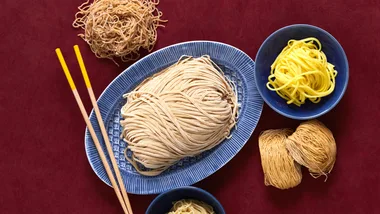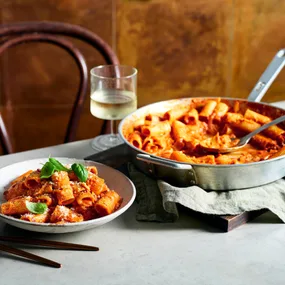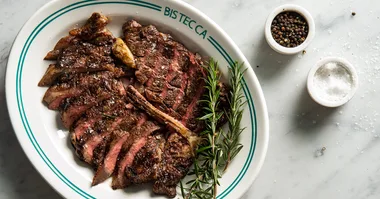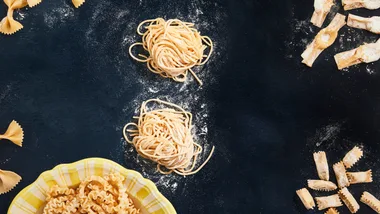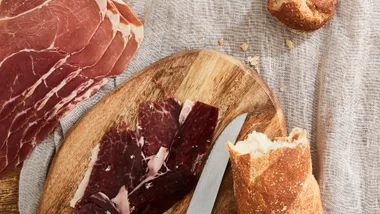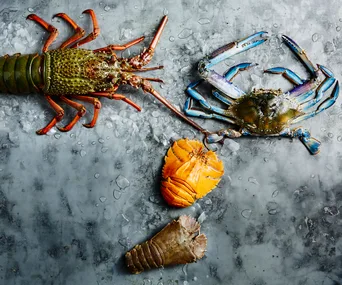For more great lamb recipes, check out our lamb recipe slideshow.
Lamb ribs
These are great in a Chinese steamboat. Start with a chicken or lamb stock base mixed with soy, ginger and garlic, then add lamb ribs, silken tofu and julienned Asian vegetables. Or you can marinate your ribs in soy, hoi sin, honey, agrodolce red wine vinegar, garlic and ginger – marinate for four hours or overnight and then bake them in the oven at 170C for around an hour, turning once until the meat is well-done.
Lamb necks
The new shanks? Try substituting them in any recipe calling for beef cheeks. Make sure you cook them long enough that you can fork all the meat off the bone before serving. If you’ve bought lamb neck chops, trim them of excess fat and use them in a classic Lancashire hotpot with plenty of root vegetables and a sprig or two of thyme.
Lamb forequarter chops
These are best cooked past medium. They’re great with gentle marinades (think olive oil, garlic and lemon zest) on a slow South American-style char-grill.
Lamb loin chops
It’s a good idea not to cook the loin meat part of the chop past medium; once this is done, lay it on the grill tail-down to take this bit of the chop to well done. You end up with the best of both worlds: crisp, unctuous tail with delicate juicy loin. An alternate to this is to cook the chop with the tail sitting on the hot-spot of your grill and the loin on a cooler section.
**Lamb chump chops
**These are a bit of an endangered species now with the rise in popularity of the lamb rump, but they remain a good everyday chop. I like to make a wet rub for them, either in a Middle Eastern style (cumin, garlic, turmeric, chilli, allspice, coriander, lemon juice) or something more Indian (fresh ginger, garlic, cumin, cayenne, garam marsala, lemon). Smear the rub on your chops a few hours ahead or the night before and then bake them in a hot oven for 7 or 8 minutes. Turn them over, smear again with plain yoghurt or hummus, bake for another 7 or 8 minutes (or until medium) and serve with spiced chickpeas.
Lamb shanks
You have your own favourite recipes for shanks, I’m sure. I can tell you, though, that roasting a pan full of browned and seasoned hindquarter shanks is one way to stop family arguments over who gets the shank end from a roasted leg of lamb.
**Lamb shoulder
**Try a shepherd’s pie pot roast. In our family shepherd’s pie was always made with leftover leg of lamb, but made from scratch with a shoulder, it’s a sensational dish in its own right. Cook off a whole square-cut forequarter of lamb, shred the meat, mix through the pan juices, top the lot with creamy mashed potato and bake till the mash begins to brown.
**Lamb breast and lamb flaps
**Either bone these yourself or find an understanding butcher for a very rewarding and unusual cut. They need to be cooked slowly and weighed down (either by the air pressure of a pressure cooker when braising in a masterstock or under a heavy ceramic dish when dry roasting) so the fat renders off. Once they’re tender, add some crunch by crumbing them lightly and frying them. Served with a piquant rémoulade, they’re hard to beat.
Leg of lamb
My first preference for leg is to butterfly it and marinate it in olive oil with a mix of some of the other flavours that suit lamb (a quality plain yoghurt with mint, lemon and garlic or sherry, honey, mild mustard, lemon and garlic). Butterflying the leg slashes through the four or five muscle groups there and means the muscle bundles can’t tighten in the cooking process. Strip the meat after cooking and serve atop seasoned couscous or cracked wheat. Leg of lamb can be tricky to roast perfectly because there can be up to five different muscle groups in the one cut of leg. I find the best way around this is to cook the leg as slow and low as possible, stopping when the inside of the thickest part of the leg reads 60C on a meat thermometer.
Lamb rump
A very popular cut in the restaurant trade and with good reason – of all the muscles in the leg this is the most suited to being roasted to medium or medium-rare. All the classic lamb seasonings go well with rump but southern French flavours like olive oil, bay, thyme, tarragon, fennel, marjoram, red wine and shallots come up particularly nicely, as does a Greek version with olive oil, garlic, oregano, thyme and lemon juice. Brown first, then place in a medium oven for 15 to 20 minutes
**Lamb backstraps
**Here’s a tip: better quality lamb backstraps are normally sold “short”. This means the rack was good enough to sell to someone as a rack. Long backstraps have both the loin and rack meat and are generally prepared from the lowest-grade lambs.
I prefer to use a lamb “porterhouse” which has the selvage fat left on the outside of the backstrap. I score the fat, season it well, brown it off on all sides and then pop it in a low oven (around 160C) for 20 minutes. This works best served with something that can cut through the richness. Try a rocket, pear and parmesan salad or a tabouli with diced preserved lemon.
Lamb stock
A number of Australian chefs use lamb stock in many of their dishes to deliver a flavour strength midway between chicken and beef stocks. It’s important to roast the bones when you’re making a lamb stock, but the really critical thing is to continuously skim the fat off the top as you go.
Lamb’s liver
This is a real delicacy and we’re fortunate to have an abundant supply of this fantastic product. Lamb’s fry from a milk-fed lamb is a wondrous thing and needs nothing more than simple grilling then dipping into something like a Madeira sauce.
**Lamb offal in general
** For some reason lamb offal isn’t revered in the same manner as veal offal, yet in my opinion it performs as well if not better in nearly all instances. Lamb’s tongues, brains, sweetbreads, kidney and liver are amazing if sourced from either the right lambs or lambs at the right time of year – spring, for instance.
**Rack of lamb
**This is such a good cut it needs little done to it to get a winning result. The best thing is to keep it simple with the meat – no marinating, smearing or anything like that. If you want to introduce other flavours, put them in a sauce; tarragon and lemon in the pan juices, for instance, or a classic red wine and shallot sauce. Even then, serve it on the side. When lamb tastes this good, why mess with it?
Richard Gunner’s Feast Fine Foods
This Gourmet Traveller online exclusive was published in August 2009.
 Chris Chen
Chris Chen

